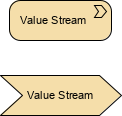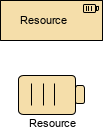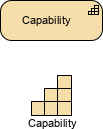Value Stream Mapping: Artifact of Vision Phase
Value stream mapping (VSM) is a visual tool used to analyze and improve the flow of materials and information required to bring a product or service to customers. It is a critical component of lean manufacturing and continuous improvement methodologies. The process involves mapping the entire value stream, from raw materials to the finished product, and identifying areas of waste, inefficiency, and bottlenecks that can be targeted for improvement. By reducing waste and improving flow, value stream mapping can help organizations increase efficiency, reduce lead times, and improve customer satisfaction.
Key Concepts of Value Stream
Value can have different meanings depending on the context, but in general, it refers to the usefulness or importance of something, typically in relation to a specific goal or purpose. For example, in business, value can refer to the benefits that a product or service provides to customers, or to the profitability that a particular activity generates for the organization.
A value stream is a sequence of activities or processes that add value to a product or service from the customer’s perspective. It represents the entire end-to-end process, from the initial request or order to the delivery of the final product or service to the customer. Value streams are important because they help organizations identify inefficiencies and waste, and find opportunities for improvement and optimization.

Value Stream Analysis in TOGAF ADM
Value stream mapping is not a specific technique or activity within The Open Group Architecture Framework (TOGAF) Architecture Development Method (ADM). However, TOGAF does provide guidance on how to identify and prioritize business capabilities, which can be a useful starting point for value stream mapping.
A value stream can be described as a series of activities or steps that an organization undertakes to deliver value to its stakeholders. It encompasses all the processes, resources, and capabilities involved in creating and delivering a product or service. Value streams are typically represented in a visual diagram format, but they can also be described using four standard elements: name, description, stakeholder, and value.
The name of a value stream should be clear and understandable from the perspective of the initiating stakeholder, using an active verb-noun construct. The description provides additional clarity on the scope of activities involved in the value stream. The stakeholder is the person or role that triggers the value stream, and the value is the benefit that the stakeholder expects to receive upon successful completion of the value stream.
For example, the value stream “Acquire Retail Product” involves the activities of looking for, selecting, and obtaining a desired retail product. The stakeholder is a retail shopper wishing to purchase a product, and the value is that customers are able to locate desired products and obtain them in a timely manner. By understanding and optimizing the value stream, organizations can streamline their processes and deliver greater value to their stakeholders.
| Name | Acquire Retail Product |
| Description | The activities involved in looking for, selecting, and obtaining a desired retail product. |
| Stakeholder | A retail shopper wishing to purchase a product. |
| Value | Customers are able to locate desired products and obtain them in a timely manner. |
Example: Develop New Product
We will use the value stream of “Develop New Product” as an example. The value stream is defined as follows:
| Name | Develop New Product |
|---|---|
| Description | The activities involved in researching, designing, testing, and launching a new product. |
| Stakeholder | A product manager or product development team. |
| Value | A new product that meets customer needs and generates revenue for the organization. |
The next step is to decompose the value stream into a sequence of value-creating stages. The table below shows the key elements of each value stream stage:
| Value Stream Stage | Description | Participating Stakeholders | Entrance Criteria | Exit Criteria | Value Items |
|---|---|---|---|---|---|
| Ideation | The act of generating and selecting product ideas. | Product Manager<br>Product Development Team | Product idea identified | Product idea selected for development | Product ideas generated |
| Requirements Gathering | The act of gathering customer and market requirements for the product. | Product Manager<br>Product Development Team<br>Customers<br>Market Research Team | Product idea selected for development | Requirements defined and prioritized | Customer requirements defined |
| Design | The act of creating a product design that meets customer and market requirements. | Product Manager<br>Product Development Team<br>Designers | Requirements defined and prioritized | Product design completed | Product design created |
| Development | The act of building and testing the product. | Product Manager<br>Product Development Team<br>Developers<br>Testers | Product design completed | Product tested and validated | Working product |
| Launch | The act of releasing the product to the market. | Product Manager<br>Product Development Team<br>Marketing<br>Sales | Product tested and validated | Product launched | Product revenue generated |
By decomposing the value stream into these stages, organizations can better understand the end-to-end process of developing a new product, identify areas for improvement, and optimize the delivery of value to their stakeholders.
Example: Customer Order Fulfillment
We will use the value stream of “Customer Order Fulfillment” to illustrate the value stream mapping process in the context of a manufacturing company. This value stream is defined as follows:
| Name | Customer Order Fulfillment |
|---|---|
| Description | The process of fulfilling a customer order from the time of order receipt to delivery of product. |
| Stakeholder | A customer placing an order for a product. |
| Value | Customers receive the product they ordered in a timely manner. |
Next, we can break down the value stream into a sequence of value-creating stages. Here’s an example of what this might look like:
| Value Stream Stage | Description | Participating Stakeholders | Entrance Criteria | Exit Criteria | Value Items |
|---|---|---|---|---|---|
| Receive Order | The process of receiving a customer order. | Sales team<br>Customer Service team | Customer places order | Order information verified | Customer order is received |
| Validate Order | The process of validating the customer order to ensure it can be fulfilled. | Order Management team<br>Inventory Management team | Order information verified | Order is confirmed | Valid order is confirmed |
| Pick and Pack | The process of picking and packing the product for shipment. | Warehouse team<br>Shipping team | Order is confirmed | Order is packed and ready for shipment | Product is picked and packed |
| Ship Product | The process of shipping the product to the customer. | Shipping team<br>Delivery team | Order is packed and ready for shipment | Product is delivered to customer | Product is delivered to customer |
Once we have mapped out the value stream and its stages, we can identify areas for improvement and optimization. For example, we might identify bottlenecks or inefficiencies in the process and look for ways to streamline or automate certain stages to reduce lead times and improve the overall customer experience.
Example: Restaurant (with Action Plan)
Here’s an example of a value stream analysis for a restaurant:
Value Stream: Customer Dining Experience
Description: The process of providing customers with a satisfying dining experience from the moment they arrive until they leave the restaurant.
Stakeholder: Restaurant customers
Value: Customers enjoy a delicious meal and a pleasant atmosphere that encourages them to return and recommend the restaurant to others.
Customer Dining Experience Value Stream Stages
| Value Stream Stage | Description | Participating Stakeholders | Entrance Criteria | Exit Criteria | Value Items |
|---|---|---|---|---|---|
| Reservation and Seating | The process of booking and seating customers at their desired table. | Host/Hostess | Customer makes a reservation or arrives at the restaurant | Customer is seated | Customers are seated in a timely and efficient manner. |
| Order Placement | The process of taking and submitting orders to the kitchen. | Waitstaff | Customer is seated | Order is submitted to the kitchen | Accurate orders are delivered to the kitchen in a timely manner. |
| Food Preparation | The process of preparing food according to customer orders. | Kitchen Staff | Order is submitted to the kitchen | Food is ready for serving | Food is prepared to order and meets customer expectations. |
| Food Delivery | The process of delivering food to the customer’s table. | Waitstaff | Food is ready for serving | Food is delivered to the customer’s table | Food is delivered to the correct table in a timely and professional manner. |
| Dining Experience | The process of creating a comfortable and enjoyable atmosphere for customers. | Waitstaff | Food is delivered to the table | Customers leave the restaurant | Customers have an enjoyable and memorable dining experience. |
By analyzing the value stream for the customer dining experience, the restaurant can identify potential areas for improvement and take action to enhance the quality of their service, ultimately leading to increased customer satisfaction and loyalty.
Action Plan
Based on the findings outlined in the table, some potential areas for improvement and corresponding action steps could include:
| Potential Area for Improvement | Action Step |
|---|---|
| Slow response times for customer support inquiries | Conduct a review of customer support processes to identify bottlenecks and areas for improvement. Implement new process changes as needed to streamline support and reduce response times. |
| Limited payment options for online purchases | Research additional payment options and integrate new payment methods into the website. |
| Inconsistent product availability across stores and online | Conduct a review of inventory management processes and systems to identify areas for improvement. Consider implementing a centralized inventory management system to improve tracking and forecasting. |
| Inadequate product descriptions and images online | Hire additional staff to improve product descriptions and photography. Implement new processes to ensure consistent and high-quality product images and descriptions. |
| Poor website performance during peak traffic times | Conduct a review of website infrastructure and performance during peak traffic times. Identify any bottlenecks or capacity issues and implement changes to improve website speed and reliability. |
| Ineffective email marketing campaigns | Conduct a review of email marketing processes and campaigns. Analyze email open and click-through rates, and adjust campaigns to improve engagement and conversions. |
| Limited social media presence | Develop a social media strategy and increase presence on social media platforms. Create engaging content and promotions to build a following and improve brand awareness. |
Of course, the specific action steps needed to address these areas for improvement may vary depending on the company, its resources, and its goals. However, this table provides a starting point for identifying potential action steps to address the issues identified in the earlier table of findings.
Representing Value Stream Mapping with ArchiMate Strategy Layer
Archimate is a powerful tool for visualizing the high-level view of value stream mapping. It can help organizations to identify opportunities for improvement and waste reduction in their processes, by providing a graphical representation of the value stream and the capabilities required to support each stage. The example provided describes a high-level value stream for an insurance company, highlighting the capabilities required to support each stage of the value stream and the associated value flows.
Mapping Value Streams to Business Capabilities with ArchiMate
The process of mapping value streams to business capabilities involves using the company’s business capability model to identify the critical business capabilities required to enable each stage of the value stream. This process is guided by a group of experts, led by the Business Architect, who focus on each stage in turn and select the most important capabilities for that stage. The level of detail in the mapping is determined by the clarity on which specific capabilities contribute directly to supporting that stage and generating business value.
If all level 2 capabilities under a level 1 (parent) capability directly enable a stage, then only the level 1 capability needs to be shown in the mapping. However, if only certain level 2 (or lower level) capabilities are included, then each of those capabilities needs to be explicitly shown in the mapping. The ArchiMate diagram provides an example of how the mapping can be done with varying levels of detail. This mapping process helps organizations to align their capabilities with their value streams, enabling them to optimize their processes and improve the overall value delivered to customers and stakeholders.

With ArchiMate, you can create models that show the flow of value through the organization, from the initial request or need to the delivery of the final product or service. This allows you to see the entire value stream in one place and identify any areas where the process is inefficient or where resources are being used ineffectively.
By cross-mapping the capabilities required to support each stage of the value stream, you can also identify areas where improvements can be made. For example, if a particular capability is not being fully utilized, it may be possible to reallocate resources or streamline the process to improve efficiency.
Overall, ArchiMate can help organizations to optimize their processes and improve the overall value delivered to customers and stakeholders. By visualizing the value stream and the capabilities required to support it, organizations can identify opportunities for improvement and make data-driven decisions to improve their processes and deliver more value to their customers.
ArchiMate Strategy Layer Elements
The Strategy Layer of ArchiMate 3.0 consists of Resource, Capability, and Course of Action elements that are essential for capability-based planning and strategic activities within an enterprise. These elements provide a high-level view of the assets, abilities, and sequences of activities that create value for customers, stakeholders, or end-users. The following table summarizes the definitions of each Strategy element and their corresponding notation in ArchiMate:
| Element | Description | Notation |
|---|---|---|
| Resource | An asset that is owned or controlled by an individual or organization. | 
|
| Capability | An ability that an active structure element, such as an organization, person, or system, possesses. | 
|
| Value Stream | A sequence of activities that creates an overall result for a customer, stakeholder, or end-user. | 
|
| Course of Action | An approach or plan for configuring some capabilities and resources of the enterprise, undertaken to achieve a goal. | 
|
Overall, these elements help organizations to better understand their capabilities and resources, and to align them with their strategic goals and objectives. By utilizing ArchiMate to visualize these elements, enterprises can make informed decisions about their strategic initiatives and improve their overall performance.
Summary
Value stream mapping is a powerful tool for improving the flow of materials and information required to bring a product or service to customers. By mapping the entire value stream and identifying areas of waste and inefficiency, organizations can target areas for improvement and increase efficiency, reduce lead times, and improve customer satisfaction. VSM is a critical component of lean manufacturing and continuous improvement methodologies and can help organizations achieve their operational and strategic goals.

